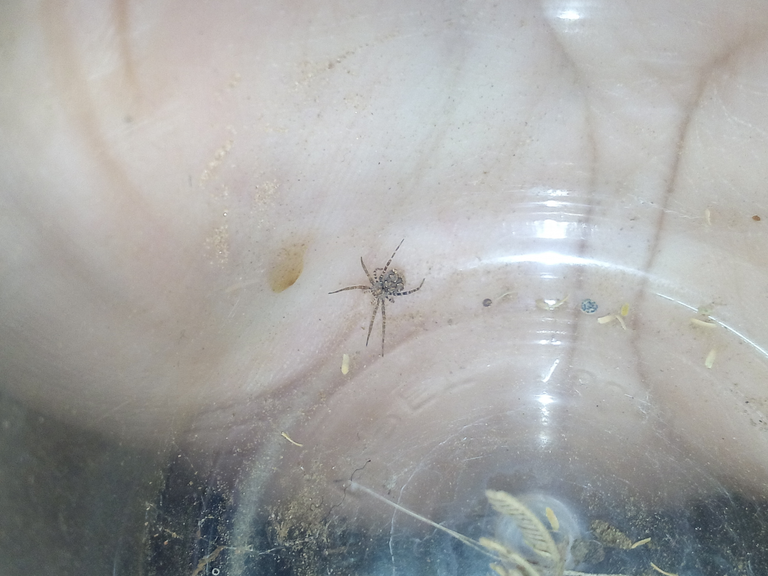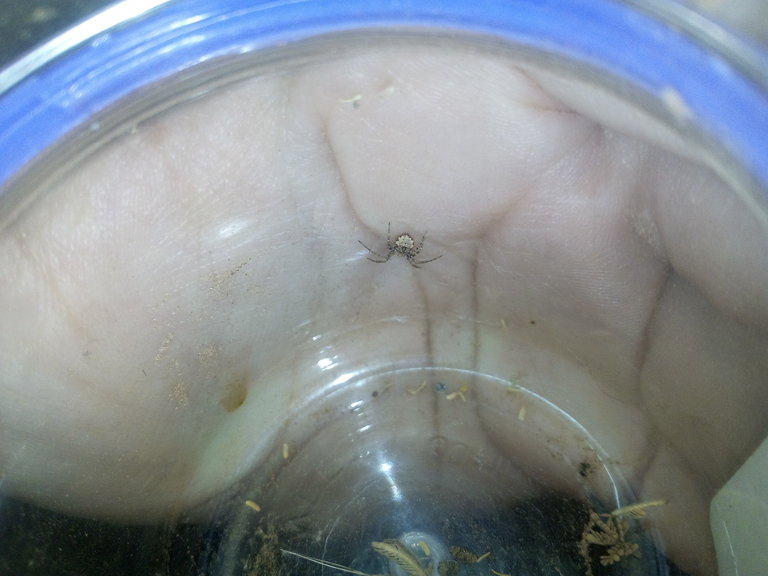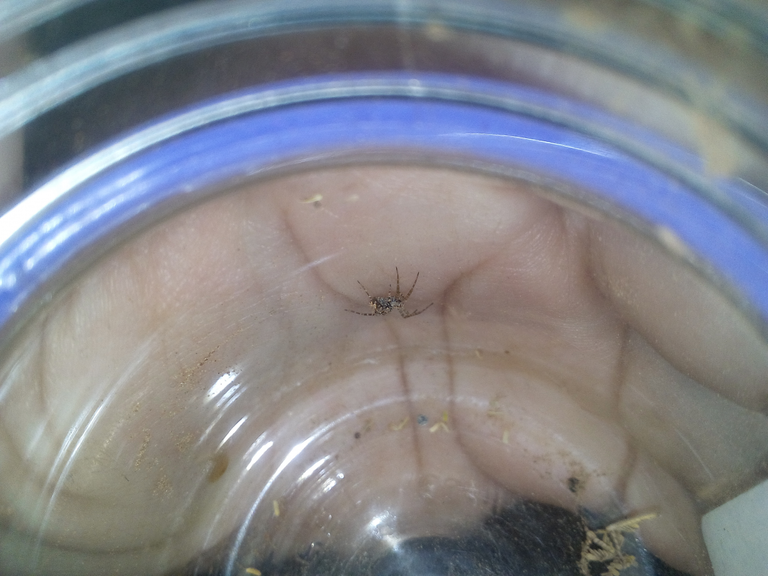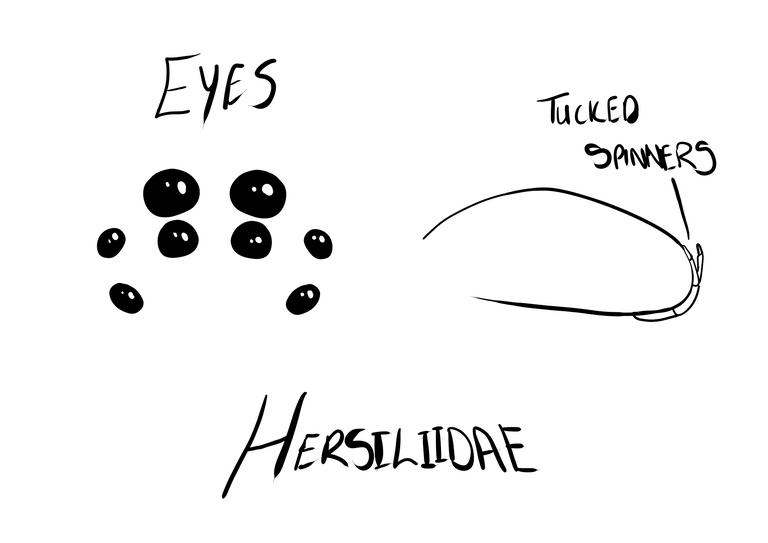Tyrotama arida [Cape Arid Long-Spinnered Desert Spider]
G'day, Hive!
A special spider today, a cryptic one, master at camouflage, and a little funny to observe hunting. This spider is from the family Hersiliidae, or commonly known as the Two-Tailed or Long-Spinnered Bark/Tree/Ground spiders. Many names. The common names also change between the genera in this family.
For instance, the species in the genus Tyrotama that we'll be looking at. They're called the Long-Spinnered Desert/Ground spider. And it's a genus endemic to South Africa. This species, specifically, has been found mostly in the Karoo, a semi-desert biome.
• TYROTAMA ARIDA •

Hersiliidae are generally found on trees or shrubs, against bark. Thus why they're called tree or bark spiders. They camouflage almost perfectly against bark thanks to their flat bodies and cryptic colouration along with the patterns on their abdomens. But these same attributes are also excellent for hiding against rock, especially in dry veld lands.
And more so especially when they rest against the ysterklip (translated to "iron rock", a type of dolerite found in my area) like the Tyrotama genus of these spiders do. The sun-scorched rock often has scattering colours of yellow, brown, and red, in mottled patterns across its surface.
• GENUS •

At first, I didn't have a clue what spider this female was, no idea which family she belonged to. Up until then, I didn't consider bark spiders because I couldn't see the two long spinnerets that are iconic for the family. When I took a closer look at her, however, I saw them and knew then she was Hersiliidae. But then, which genus?
What genus has shorter spinnerets AND tucks them away? Surprisingly, only one in South Africa. So, really, it was a matter of quick researching and I found she was a Tyrotama sp. That left me trying to figure out the species, which was a little more difficult.
For one, a few of the Tyrotama species have similar markings and colours. The slight variations proved frustrating, even with reading the descriptions in the literature. Like with the grass running spider, a revision of the Afrotropic long-spinnered spiders helped in determining this species.
It boiled down to, essentially, the yellow on the posterior half of the dorsal abdomen along with the dark chevron-like heart-marking in the anterior dorsal, and the dark colour on the sides. Along with those is the dark eye region and the fact that the 4th leg pair is the longest. Not the best identification markers, granted, but they hold. Along with location, of course.
• DESCRIPTION •

Taxon:
- Class: Arachnida
- Order: Araneae
- Infra-Order: Araneamorph (true spiders)
- Family: Hersiliidae
- Genus: Tyrotama
- Species: T. arida
Female
Around 4mm in body length. Leg span of approximately 10mm diagonally.
Cephalothorax:
Round cephalothorax. Carapace light sandy brown with orange-ish oval in centre, faint line on either side, and thin dark lines on side edges. Sternum small and almost triangular, faintly mottled. Pedipalps like legs, unmodified.
Abdomen:
Abdomen oval, yellowish with darker chevron-like pattern down dorsal centre containing two dark inverted triangle markings anterior. Tips of chevron pattern have short prominent spines. Ventral abdomen light brown and faintly mottled. Spinnerets thick and long but tucked under abdomen, reddish brown.
Legs:
First two leg pairs light brown and banded, last two pairs darker brown and banded. Legs 4, 2, 1, 3.
Male
Unknown.
• ABOUT THE GENUS •

Tyrotama is a particularly strange genus of the Long-Spinnered spider family. Contrary to the common name, Tyrotama spiders have relatively short spinnerets though still longer than the average spider's in proportion to their body size. When looking at one, it's difficult to see the spinnerets because they're tucked against the abdomen until they're needed.
Like when they catch prey. They'll run around the prey, using their long spinnerets to wrap it with silk, before giving the killing bite.
Tyrotama, like the one I spotted, are found under rocks and stone where they build their nests. They also make their egg sac under these rocks, leaving them hanging and camouflaging them with chips of stone and debris. It sort of looks like a ball of filth hanging on a line. But very, very small.
• NOTES •
When I collected this female T. arida, it was from underneath a smaller ysterklip. She ran out quickly as soon as I lifted it. Once I collected her, she proceeded to run around the circumference of the container repeatedly until I left the container to sit for a few minutes.
I came across several other T. arida under rocks and they quickly scattered into the veld when I disturbed them. Their markings made that they disappeared from sight almost instantly. I have yet to find any egg sacs, however. Their camouflage is really excellent.

Yay! 🤗
Your content has been boosted with Ecency Points, by @anikekirsten.
Use Ecency daily to boost your growth on platform!
Support Ecency
Vote for new Proposal
Delegate HP and earn more
Your knowledge on spiders always excellent and valuable.
!LUV Photography and detail.
@joanstewart(3/10) gave you LUV. tools | wallet | discord | community | <>< daily
tools | wallet | discord | community | <>< daily
HiveBuzz.me NFT for Peace